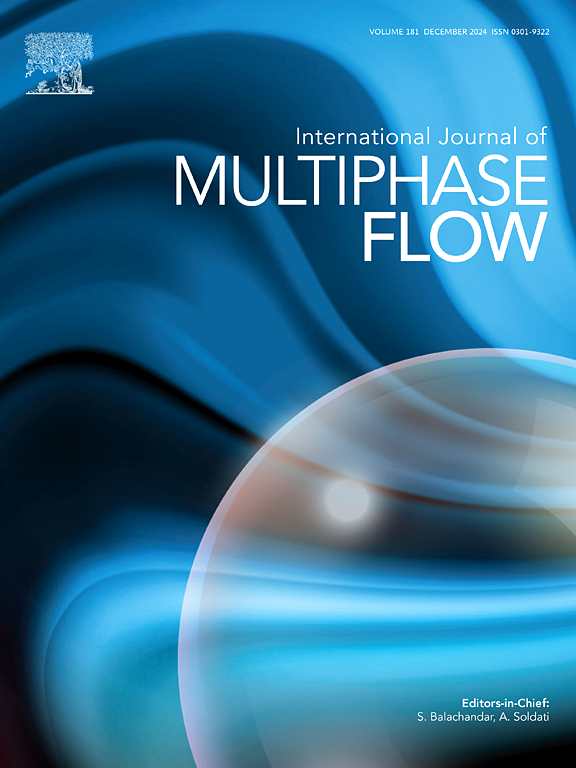管状填料床中液滴流动系统的压降实验与建模
IF 3.8
2区 工程技术
Q1 MECHANICS
International Journal of Multiphase Flow
Pub Date : 2025-09-22
DOI:10.1016/j.ijmultiphaseflow.2025.105462
引用次数: 0
摘要
在液滴流动系统中,压降是反映能量耗散的关键参数,它直接影响液滴的动力学,从而指导设备的设计和优化。大多数液滴流动压降的建模研究主要集中在均匀流体流动假设下的摩擦压降。由于忽略了界面阻力对压降的影响,导致对压降缺乏更深入的机理理解,现有模型的预测精度有限。为了系统地量化界面阻力,在管状填充床中进行了液滴流动实验。研究了界面阻力与液滴尺寸的耦合关系,建立了综合摩擦阻力和界面阻力的压降模型。首先,使用显微摄影技术捕捉液滴大小的变化。随后,测量了不同流速、分散相含率和填料床直径下的压降。通过液滴动力学分析,讨论了界面阻力对压降的影响。最后,建立了界面阻力与液滴尺寸之间的关系。提出了结合摩擦压降和界面压降的模型,平均相对误差为2.08%。此外,验证实验证实,所建立的模型准确地捕捉了界面阻力机制的贡献,并大大提高了液滴流动系统压降预测的准确性。本文章由计算机程序翻译,如有差异,请以英文原文为准。

Experiments and modeling of pressure drop for the droplet flow system in a tubular packed bed
In droplet flow systems, pressure drop is a critical parameter reflecting energy dissipation, which directly impacts the droplet dynamics and consequently guides the equipment design and optimization. Most modeling studies on droplet flow pressure drop primarily focus on the frictional pressure drop under the homogeneous fluid flow assumption. The contribution of interfacial drag to the pressure drop is overlooked, which leads to a lack of deeper mechanistic understanding of pressure drop and the limited predictive accuracy of current models. In this work, the droplet flow experiments in a tubular packed bed were performed to systematically quantify the interfacial drag. The coupling of interfacial drag with droplet size was characterized and a pressure drop model integrating both frictional and interfacial contributions was developed. First, the variation in droplet size was captured using a microphotography technique. Subsequently, the pressure drop was measured with varying flow velocity, dispersed phase holdup, and packed bed diameter. The contribution of interfacial drag to pressure drop was discussed by analyzing droplet dynamics. Finally, the correlation between interfacial drag and droplet size was established. A model combining the frictional and interfacial pressure drop was proposed, achieving a mean relative error of 2.08%. Furthermore, validation experiments confirmed that the developed model precisely captures the contribution of interfacial drag mechanisms and substantially enhances the accuracy of pressure drop prediction in droplet flow systems.
求助全文
通过发布文献求助,成功后即可免费获取论文全文。
去求助
来源期刊
CiteScore
7.30
自引率
10.50%
发文量
244
审稿时长
4 months
期刊介绍:
The International Journal of Multiphase Flow publishes analytical, numerical and experimental articles of lasting interest. The scope of the journal includes all aspects of mass, momentum and energy exchange phenomena among different phases such as occur in disperse flows, gas–liquid and liquid–liquid flows, flows in porous media, boiling, granular flows and others.
The journal publishes full papers, brief communications and conference announcements.

 求助内容:
求助内容: 应助结果提醒方式:
应助结果提醒方式:


